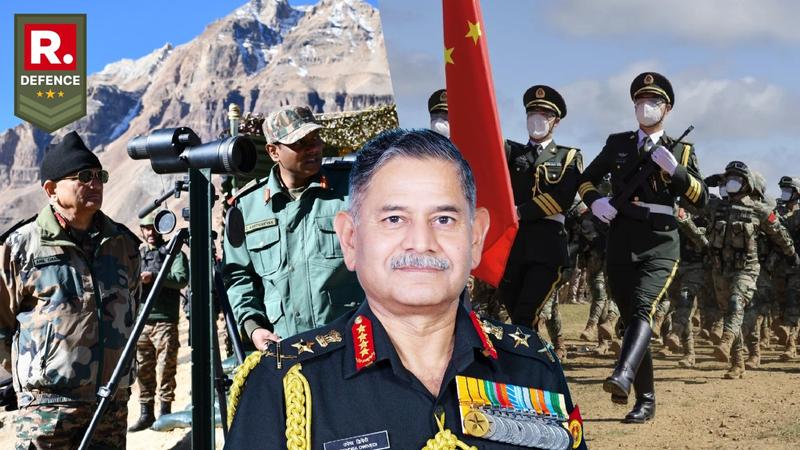Published 18:06 IST, October 22nd 2024
India, China Disengage Troops, Agree to Resume Patrolling Along LAC After 4 Years
India announced a significant breakthrough in its four-year military standoff with China, reaching an agreement on patrolling arrangements along the LAC.

New Delhi, India — India announced on Monday that it has reached a crucial agreement with China on patrolling arrangements along the Line of Actual Control (LAC), marking a breakthrough in the four-year-old military standoff. This agreement raises the prospect of a meeting between Indian Prime Minister Narendra Modi and Chinese President Xi Jinping during the upcoming BRICS Summit in Kazan, Russia.
Foreign Secretary Vikram Misri provided details of the agreement, emphasizing that the disengagement process with China has been completed, effectively restoring the situation to what it was before the tensions in 2020. "As a result of these discussions, an agreement has been arrived at on patrolling arrangements along the Line of Actual Control in the India-China border areas, leading to disengagement and a resolution of the issues that had arisen in these areas in 2020," Misri said.
External Affairs Minister S. Jaishankar also highlighted the significance of this development, stating, “We have gone back to where the situation was in 2020, and... the disengagement process with China, you can say, has been completed.”
COAS General Upendra Dwivedi on LAC Developments
Adding to the discourse, Chief of Army Staff (COAS) General Upendra Dwivedi shared the Indian Army's strategic perspective on the recent agreement. Speaking on the disengagement process, Gen Dwivedi stated, “We want to go back to the status quo of April 2020. Thereafter, we will be looking at disengagement, de-escalation, and the normal management of the Line of Actual Control (LAC).”
General Dwivedi also underscored the importance of restoring trust between the two sides. “As of now, we are trying to restore the trust. How the trust will be restored? It will get restored once we are able to see each other. Patrolling gives you that kind of advantage," he remarked, emphasizing that trust-building will be crucial for the success of the disengagement and eventual de-escalation.
The COAS also pointed out that the process involves several phases and will not stop at the immediate resolution. “There are phases in that... We are trying to restore the trust, and as we restore the trust, the other stages will also follow soon.”

The military's approach to restoring normalcy along the LAC remains consistent with its long-standing strategy. "It has been our stance from April 2020, when General Joshi was the Army Commander, and even today, that remains the same," said Gen Dwivedi, indicating that the military has been pursuing the same objective since the onset of the tensions.
General Dwivedi emphasized that both sides need to reassure each other to prevent creeping encroachments, particularly in buffer zones. “The buffer zones which have been created... We are not creeping, and both have to reassure each other. Patrolling gives you that kind of advantage," he said, adding that the military sees this as a vital part of restoring trust between the two sides.
The Path to Normalcy
The latest agreement signals a significant step forward in restoring peace along the LAC, with both military and diplomatic efforts working in tandem. Jaishankar remarked that the agreement on “observing the sanctity of the LAC” lays the foundation for a return to the peace and tranquillity that existed before the 2020 confrontation. He pointed out that both sides will now resume patrolling activities as they did before the standoff began.
Jaishankar also reflected on the long diplomatic process behind the agreement. “At various points in time, people almost gave up. We have always maintained that, on the one hand, we had to obviously do the counter-deployments, but side by side, we have been negotiating,” he said, referring to the ongoing negotiations that began after a tense meeting with Chinese Foreign Minister Wang Yi in Moscow in September 2020.

General Dwivedi echoed this sentiment from a military standpoint, reiterating that patrolling will play a pivotal role in rebuilding trust and ensuring a phased disengagement process. As both sides move forward, he suggested that diplomatic and military cooperation will continue to drive progress.
Prospects of Modi-Xi Meeting at BRICS Summit
The breakthrough also raises the likelihood of a high-level meeting between Prime Minister Modi and President Xi during the BRICS Summit in Russia. While there has been no official confirmation of a bilateral meeting, sources familiar with the matter have indicated that the latest agreement could set the stage for further discussions between the two leaders.
Modi and Xi last met on the sidelines of the G20 Summit in Indonesia in November 2022, and a potential meeting in Kazan would present an opportunity to reinforce diplomatic ties, particularly in the wake of the successful disengagement process at the LAC.
Background of the LAC Standoff
The LAC standoff began in May 2020 when Indian and Chinese troops clashed on the banks of Pangong Lake, escalating into a violent confrontation in the Galwan Valley in June 2020. The clash resulted in the deaths of 20 Indian soldiers and at least four Chinese troops—the first fatalities on the LAC in 45 years. The conflict plunged India-China relations to their lowest point since the 1962 border war, prompting military deployments and diplomatic efforts to ease tensions.

Over the past four years, both sides have engaged in several rounds of diplomatic talks, facilitated by the Working Mechanism for Consultation and Coordination (WMCC) on India-China Border Affairs, which includes senior military commanders and diplomats. These discussions led to the withdrawal of frontline troops from key friction points, including Pangong Lake, Gogra, and Hot Springs. However, two critical areas—Depsang and Demchok—remained unresolved until the recent breakthrough.
Updated 18:06 IST, October 22nd 2024




